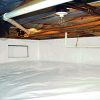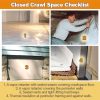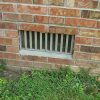Your floors are cold but the last time you checked, the floor joists above the crawlspace were stuffed with batts of fluffy insulation. What gives?
Homeowners whose homes are built over crawlspaces may wonder about this. Or they may simply turn up the thermostat and resign themselves to higher utility bills. Regardless, it’s not really a mystery if you understand why a crawlspace insulated with fiberglass is a really batty idea.
First consider that most crawlspaces are not sealed. Warm humid air in summer can easily find its way through vents, ill-fitting hatchways, and the small gaps in the framing that rests atop foundation walls. As this moisture-laden air cools and reaches its dew point, condensation quickly forms on cool crawlspace surfaces – including the aforementioned insulation. Moisture adds weight to the fiberglass batts, which sag, becomes dislodged, and loose their effectiveness. Gaps open up that lead directly to the subfloor above.
To compound the problem, fiberglass insulation itself is not an effective air barrier. Air can pass right through it (unlike some other forms of insulation). You can see this for yourself by examining fiberglass insulation that has been in place for several years. The fibers are often discolored and loaded with dust and dirt. In effect, the batt has functioned more like a filter than a barrier. With cold air being able to reach the floor, it’s no wonder that the floors get cold.
The most effective way to warm up your floors would be to use an insulation that both seals and insulates the underside of your subflooring. Spray foam or the installation of rigid foam board panels caulked at the edges, would perform very well in theory. Unfortunately, the joist bays overhead in a crawlspace typically host all sorts of things you’ll eventually need access to, including plumbing valves, ducts, and electric junctions. Besides, insulating just the floor will not solve a crawlspace’s moisture problem. The crawlspace will continue to be a damp, wet place that’s conducive to rot, rust, and insect infestation. Ducts will still have to travel through a cold space, loosing some the heat they are supposed to deliver to your living space. Plumbing pipes will still be susceptible to freezing.
The better way
Sealing or “encapsulating” your crawlspace involves more material and effort but is a much better solution than trying to insulate under flooring. It typically includes the installation of a tough polyethylene membrane (not unlike a pool liner) over crawlspace walls and floor. Seams are sealed with special tapes. Exterior vent covers are used to seal any existing vents. The hatchways may be weatherstripped or fitted with an airtight entry system. Gaps found along the rim joists (the perimeter framing that supports your exterior house walls) are also carefully sealed. In cold climates, rigid board insulation may be used on crawlspace walls in combination with the liner, and a flexible insulating mat may be laid under the liner.
Once encapsulated, your crawlspace becomes part of the “conditioned” (heated and cooled) portion of your home. Its temperature becomes similar to the rooms above, and your floors stay warm in winter. As a bonus, heating ducts lose less heat, interior relative humidity is controlled in summer, and pipes no longer freeze.
Getting the job done right
Sealing a crawlspace is not a complex job (in fact it can be done in a few days), but it is one that must be done right. Otherwise, it can cause more problems than it solves. If you have a water infiltration problem, for example, it needs to be taken care of before the encapsulation work begins. If the waterproofing requires a sump pump, the basin will need to be carefully fitted to the liner and covered with an airtight lid. Other little details, such as water alarms and transparent sections so inspectors can check for insect activity must also be taken into account.
Be sure to contact a specialist when you’re ready to do the job. Basement Systems, Inc., for example, pioneered the encapsulation method. Its CleanSpace™ dealers have encapsulated thousands of crawlspaces and have patented products at their disposal to ensure a successful job. There are CleanSpace dealers through North America.
So, tear out that old soggy fiberglass insulation and seal your crawlspace. In addition to warmer toes this winter, an encapsulated crawlspace will reduce excessive moisture levels and improve the energy efficiency of your home.








Hi Joe,
What if encapsulation is simply not an option? the town home I live in was originally constructed in 1940 as an army barracks. Later in the 1970s, the building was chopped up and renovated into 8 units to create 8 2-story townhomes. The problem is we all share one giant ventilated crawl space. So its impossible to just encapsulate the crawlspace beneath my house, because there is literally no separation between my and my 7 neighbors.
So, given my unique situation, what is the best way insulate just our section of the crawl space?. I have soggy, moldy, mouse-filled batty insulation that does nothing. Our wood floors are ice-cold in the winter and our bills are sky high. Please help!
Melissa: I think it’s a sure thing that your neighbors in the building are experiencing the same discomfort, along with high HVAC expenses because of the untreated crawl space. I suggest getting together to voice your concerns and (hopefully) pool your resources so that the entire crawl space can be encapsulated. With all inhabitants contributing, the cost should not be too high. But more importantly, it will be a one-time expense that benefits everyone long term. Yes, it looks like you need to become a community organizer on this one. Good luck, Tim
I agree that crawlspace encapsulation is probably the best approach to dealing with crawlspaces in general. However, I recently had an estimate for this kind of job and it came to $12,400.00 for a small (900 sq. ft.) home that is worth about $150,000.00 in the best of circumstances. That’s hard to justify, even if I would gain a bit of dry storage space from the upgrade. I’d rather just deal with “good enough” for the foreseeable future.
It seems to me that most people who can actually afford crawlspace encapsulation (at least in my area of the country) would be better off just buying a new home with a basement!
You’re right, Evan,
The decision to encapsulate a crawl space isn’t a no-brainer. Like any other home improvement or home repair, it must be evaluated in terms of cost and benefits. Energy and health issues aside, it’s wise to acknowledge the dramatic visual differences between a dirty, damp, dirt-floored crawl space and one that’s clean, dry and covered with a durable moisture barrier. The analogy I’d offer up is buying a used car. If you pop the hood and see the engine compartment covered in dirt and oily grime, what does that tell you about the car’s care in general? Some car buyers will view this as a deal-breaker, while others may only be swayed by how the car drives and how low the price is.